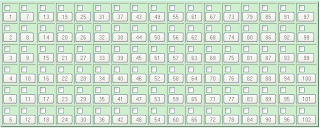Introduction to tangent function graph:
In geometry, the tangent line (or simply the tangent) to a curve at a given point is the straight line that "just touches" the curve at that point (in the sense explained more precisely below). As it passes through the point where the tangent line and the curve meet, or the point of tangency, the tangent line is "going in the same direction" as the curve, and in this sense it is the best straight-line approximation to the curve at that point. The same definition applies to space curves and curves in n-dimensional Euclidean space.
Source: Wikipedia.
Definitions of a Trigonometry Tangent Function:
Definition of tangent function is defined by using the right angle triangle
Tangent of an angle is the ratio of length of the adjacent and the opposite side.
tan x = opposite / adjacent
The tangent is the inverse of the cotangent and is given by
tan x = 1 / cot x
Quotient of sine and cosine functions is called as tan or tangent function.
tan x = sin x / cos x
Properties of a Tangent Function Using the Graph
Example Problem for Tangent of a Graph:
Example 1:
Find the function value of tan 35 o.
Solution:
Use the tangent's co function identity to solve the problem.
tan x = cot (90o – x)
tan 35o = cot (90o – 35o)
= cot (55o)
tan 35o = 0.70021
The tangent of 60o is 0.70021.
Example 2:
Find the hypotenuse of the right angle triangle using the Pythagorean Theorem and find the tangent of an angle value.
Solution:
Use the Pythagorean Theorem, for finding the hypotenuse
In the given right angle triangle
AC2 = AB2 + BC2
Here,
AB = Opposite side
BC = Adjacent side
AC = Hypotenuse
AC2 = AB2 + BC2
= 42 + 92
= 16 + 81
AC2 = 97
AC = 9.84
Hypotenuse for the given right angle triangle is 9.84
Tangent function:
Tan ? = Sin ?/ Cos ?
= adj / opp
= 4 / 9
Tan ? = 4 / 9
? = tan -1(4/9)
? = 23.96 °
In geometry, the tangent line (or simply the tangent) to a curve at a given point is the straight line that "just touches" the curve at that point (in the sense explained more precisely below). As it passes through the point where the tangent line and the curve meet, or the point of tangency, the tangent line is "going in the same direction" as the curve, and in this sense it is the best straight-line approximation to the curve at that point. The same definition applies to space curves and curves in n-dimensional Euclidean space.
Source: Wikipedia.
Definitions of a Trigonometry Tangent Function:
Definition of tangent function is defined by using the right angle triangle
Tangent of an angle is the ratio of length of the adjacent and the opposite side.
tan x = opposite / adjacent
The tangent is the inverse of the cotangent and is given by
tan x = 1 / cot x
Quotient of sine and cosine functions is called as tan or tangent function.
tan x = sin x / cos x
Properties of a Tangent Function Using the Graph
Example Problem for Tangent of a Graph:
Example 1:
Find the function value of tan 35 o.
Solution:
Use the tangent's co function identity to solve the problem.
tan x = cot (90o – x)
tan 35o = cot (90o – 35o)
= cot (55o)
tan 35o = 0.70021
The tangent of 60o is 0.70021.
Example 2:
Find the hypotenuse of the right angle triangle using the Pythagorean Theorem and find the tangent of an angle value.
Solution:
Use the Pythagorean Theorem, for finding the hypotenuse
In the given right angle triangle
AC2 = AB2 + BC2
Here,
AB = Opposite side
BC = Adjacent side
AC = Hypotenuse
AC2 = AB2 + BC2
= 42 + 92
= 16 + 81
AC2 = 97
AC = 9.84
Hypotenuse for the given right angle triangle is 9.84
Tangent function:
Tan ? = Sin ?/ Cos ?
= adj / opp
= 4 / 9
Tan ? = 4 / 9
? = tan -1(4/9)
? = 23.96 °





